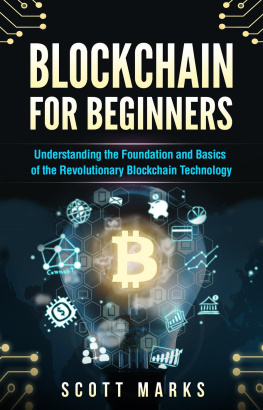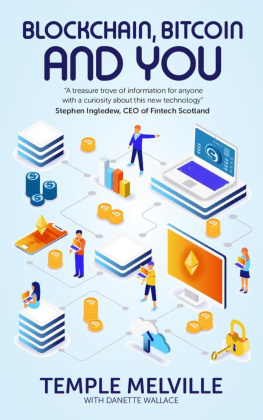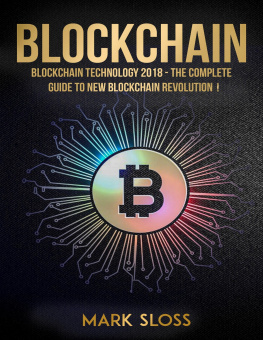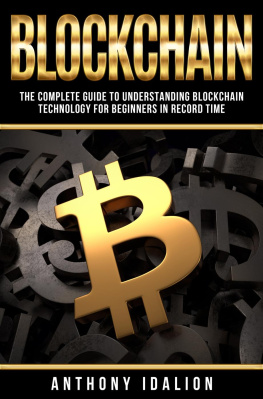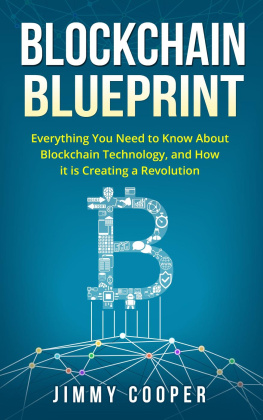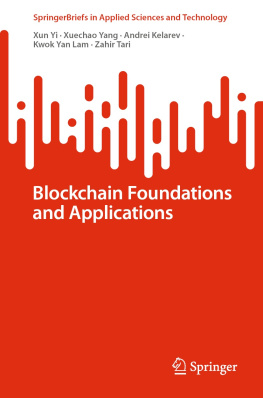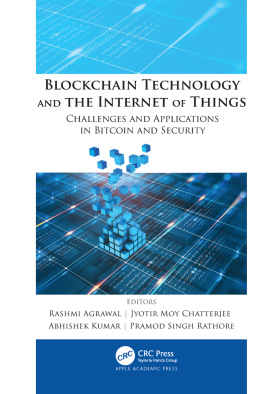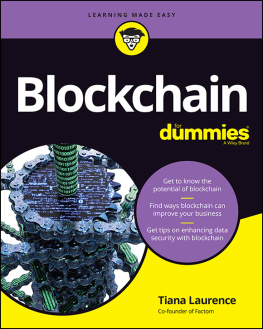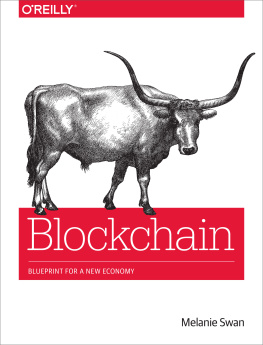BLOCKCHAIN FOR BEGINNERS
Understanding the Foundation and Basics of the Revolutionary Blockchain Technology
By Scott Marks
Table of Contents
Copyright 2017 By Scott Marks All rights reserved.
T his document is geared towards providing exact and reliable information in regards to the topic and issue covered. The publication is sold with the idea that the publisher is not required to render accounting, officially permitted, or otherwise, qualified services. If advice is necessary, legal or professional, a practiced individual in the profession should be ordered.
- From a Declaration of Principles which was accepted and approved equally by a Committee of the American Bar Association and a Committee of Publishers and Associations.
In no way is it legal to reproduce, duplicate, or transmit any part of this document in either electronic means or in printed format. Recording of this publication is strictly prohibited and any storage of this document is not allowed unless with written permission from the publisher. All rights reserved.
The information provided herein is stated to be truthful and consistent, in that any liability, in terms of inattention or otherwise, by any usage or abuse of any policies, processes, or directions contained within is the solitary and utter responsibility of the recipient reader. Under no circumstances will any legal responsibility or blame be held against the publisher for any reparation, damages, or monetary loss due to the information herein, either directly or indirectly.
Respective authors own all copyrights not held by the publisher.
The information herein is offered for informational purposes solely, and is universal as so. The presentation of the information is without contract or any type of guarantee assurance.
The trademarks that are used are without any consent, and the publication of the trademark is without permission or backing by the trademark owner. All trademarks and brands within this book are for clarifying purposes only and are the owned by the owners themselves, not affiliated with this document.
CHAPTER 1: Introduction to Understanding Blockchain
Most introductory guides to blockchain technology will begin their story in 2008, with the advent of Bitcoin. These accounts are quite accurate, but only paint half of the picture. The fundamental purpose of blockchain technology and its uses goes back much further than 2008. In order to truly grasp blockchain technology, we must reach back to the time before computers, paper currency, or even money itself. The answer to this question will take us on an adventure going back thousands of years, by first delving into the burning question of what money is, and from there, tracing its trajectory throughout history to the development of blockchain technology. This brief history of money is necessary to understand present-day corollaries with blockchain technology applications, such as Bitcoin and Ethereum, both of which will be introduced in the following chapter.
Money has had an incredible trajectory over the past five thousand years. In the beginning, what separated humans from animals was not the human capacity for strength, speed, or endurance. Rather, it was the human capacity for thought. Indeed, the name of our species, homo sapiens (literally, wise man), is a reference to the perceived wisdom of humanity. This initial spark has allowed the homo sapiens species to blossom from being a pale, naked ape-like animal to inhabiting all corners of the world and dominating other species to do its will. Not only do humans train other species to do their bidding in the way cavemen trained horses, they also have them as pets and breed them to their liking. So how did this ill-adapted primate evolve to reach these heights? The answer lies in their incredible capacity to adapt and conform to new situations and challenges. Particularly important to this development was how humans originally exchanged gifts and services. At one time, humans used the barter system; now we use money, and thats where blockchain enters.
The barter system of yesteryear was a system of exchange without the medium of exchange (this will become important when we analyze Ethereum). Put in simple English, it was trading favors and products for one another. Unlike giving gifts, the barter system allowed for the fisherman to trade fish while the hunter provided his catch. For example, Caveman Grug would agree to pay five rabbits in exchange for three salmon from Caveman Urg. This system of exchange ruled human civilization for thousands of years. However, the barter system has significant challenges and drawbacks. On the one hand, exchanges could be made easily and efficiently. On the other hand, how many pounds of salt is a pig worth? Who knows? Their services also had a time stamp on them: eventually the fish would rot or the rain will wash the salt away and your exchange was worth nothing. (This concept of the timestamp will again become important when we examine blockchain more.) Nevertheless, for the majority of human existence, the barter system prevailed as the law of the land among homo sapiens , with cavemen dealing with each other without any agreed upon medium of exchange, such as money.
It was not until much later that man left the cave so to speak and began to gather into tribes, chiefdoms, and eventually, civilizations. With the advent of agriculture, humans decided to settle in one region rather than perennially chase animals for their sustenance. For the first time ever, a division of labor was appearing among the human race. Now farmers could sell their crops, hunters could exchange their meat, and fisherman could sell their catch. But with such a variety of trades, goods, services, and products, how can a society manage it all? The answer was money. At first, money was not what we think of today. Euros, dollars, yen, British pounds, and pesos gleam in our eyes every day, but money was not always paper. For the kings and queens of antiquity, the best way to keep track of exchanges was through precious gems. Rubies, diamonds, and emeralds were the name of the game for these leaders. Notice how under the barter system, gifts and exchanges could spoil, rot, and erode away, But with precious gemstones for currency, their transactions were sustained indefinitely. This permanence and relatively abundance of gold became an important factor influencing the proliferation of this yellow metal as a tailored medium of exchange. Some societies deviated from this pattern and suffered monetary consequences. For example, in the Aztec Empire, cocoa beans were used as a form of currency. Considered a gift from their god, Quetzalcoatl, cocoa beans were a highly valued and traded commodity in the Aztec Empire. As can be predicted, cocoa currency has some drawbacks: they spoil, the beans can be grown, and they can be eaten. The Aztecs eventually suffered through these consequences through (you guessed it) counterfeit cocoa beans!
Yet, in the rest of the world, precious gemstones provided another challenge for leaders. How does the kingdom guarantee the value of the traded metals? After all, counterfeit metals were abundant. Archeologists are still finding counterfeit currency all over the world. Furthermore, who can agree to how many rubies an emerald is worth? Because of these challenges, kings and queens decided to use primarily two metals for trading goods and services: gold and silver. These metals were convenient for many reasons, but the most important were that gold and silver could be melted and formed into coins. Once melted, the kings could stamp these coins with his seal, marking them as officially backed by the kingdom. Now traders and craftsmen didnt have to negotiate a deal among themselves to discern which metal was more valuable; instead they could use the gold ensured by the king himself. With this system, craftsmen, merchants, and traders could agree that five silver coins equal one gold coin, and so on. This social contract will also be useful in understanding how cryptocurrencies, such as Ethereum operate. Thus, in the same way the caveman left to cave to the field, man the thinker became man the banker.
Next page
